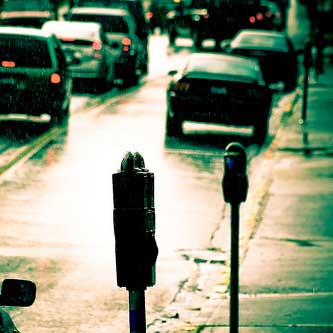 Finding street parking can be a massive headache. Drivers circle the block repeatedly; slowing to a near crawl whenever a space looks like it might be available, all while a logjam of irritated drivers slowly collects behind them. The most impatient drivers might try to sneak around the would-be street parker, and still others face an increased risk of collision due to a seemingly random or sudden stop.
Finding street parking can be a massive headache. Drivers circle the block repeatedly; slowing to a near crawl whenever a space looks like it might be available, all while a logjam of irritated drivers slowly collects behind them. The most impatient drivers might try to sneak around the would-be street parker, and still others face an increased risk of collision due to a seemingly random or sudden stop.
As Jay Primus–the manager of San Francisco’s new street parking program SFpark–points out, “Circling drivers are distracted drivers. They’re much more likely to hit pedestrians, bicyclists, and other cars, and as they search for parking spots, making frequent turns and making frequent stops, they can cause unpredictable delays to the transit system.” In fact, a study conducted in Los Angeles found that within one 15 block area, drivers ended up collectively logging an extra 350,000 miles over the course of the year just by circling around for an average of three extra minutes while trying to find parking.
Now, both San Francisco and Los Angeles are hoping to make street parking more efficient with the addition of new sensor networks. SFpark, San Francisco’s network of magnetic sensors, includes data from 8,200 different parking spaces as well as additional information from parking garages and meters that’s available to drivers in real time through their website and smartphone app. The goal of the program is to direct drivers to areas where parking is already available and cut down on the time spent hunting for an empty space.
On the downside–at least from a consumer standpoint–the program also allows for more efficient ticketing from police, who can be alerted when a vehicle’s parking has expired. However, SFpark also allows parking prices and time limits to be adjusted based on demand, which has actually resulted in 14% fewer citations. The program also boasted a 27% increase in meter revenue, thanks in large part to extending time limits in less congested parking areas and eliminating some time restrictions all together.
While using a smartphone app to help decrease distracted driving may seem counterintuitive, SFpark’s mobile version actually offers a warning message to alert drivers that, “using a smartphone while driving is dangerous and against the law.” The app also shows an additional reminder if it’s detected traveling at more than 10 miles per hour, and according to SFpark’s website, “The smartphone app and web map are expected to be accessed before a trip begins or to be operated by a passenger if accessed while in motion. SFMTA strongly discourages illegal use of the SFpark app including accessing the app while driving.”
Still, whether users of the app decide to heed the warning is a different question all together.
Photo credit: https://www.flickr.com/photos/eyermonkey/2433042946/

